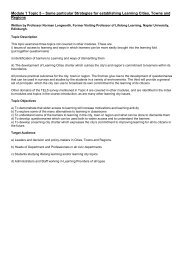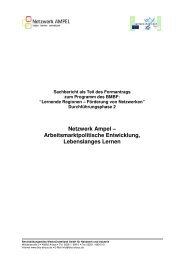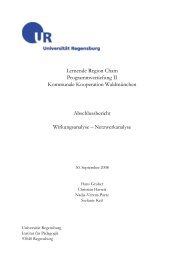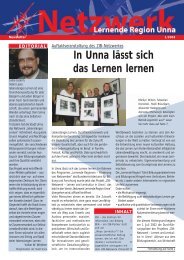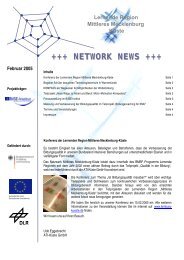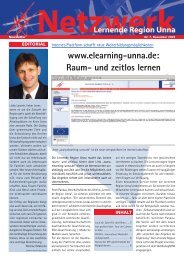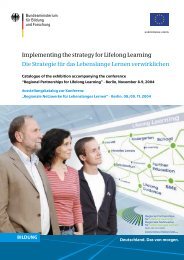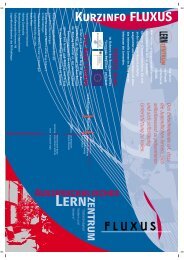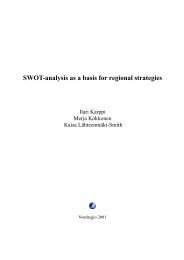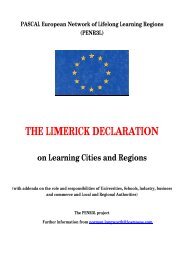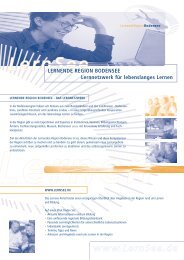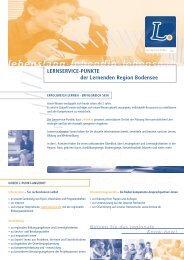OECD Observer: Learning cities: the new recipe in ... - EUROlocal
OECD Observer: Learning cities: the new recipe in ... - EUROlocal
OECD Observer: Learning cities: the new recipe in ... - EUROlocal
Create successful ePaper yourself
Turn your PDF publications into a flip-book with our unique Google optimized e-Paper software.
<strong>OECD</strong> <strong>Observer</strong>: <strong>Learn<strong>in</strong>g</strong> <strong>cities</strong>: <strong>the</strong> <strong>new</strong> <strong>recipe</strong> <strong>in</strong> regional development<br />
04/03/2011 15:07<br />
Sections » Society » General<br />
<strong>Learn<strong>in</strong>g</strong> <strong>cities</strong>: <strong>the</strong> <strong>new</strong> <strong>recipe</strong> <strong>in</strong> regional development<br />
The concept of a “learn<strong>in</strong>g” city or region is relatively <strong>new</strong>, but yet it is at <strong>the</strong> core of a grow<strong>in</strong>g number of<br />
regional development strategies. What exactly is a learn<strong>in</strong>g city? And does it work?<br />
Kurt Larsen<br />
<strong>OECD</strong> <strong>Observer</strong><br />
Page 73<br />
The city is dead. Long live <strong>the</strong> city! Those who have rushed to pronounce <strong>the</strong> city's demise <strong>in</strong> today's globalised communications<br />
world may have to eat <strong>the</strong>ir words. For <strong>cities</strong> -- and <strong>the</strong>ir regions -- can offer just <strong>the</strong> right mix of resources, <strong>in</strong>stitutional structures,<br />
modern technology and cosmopolitan values that allow <strong>the</strong>m to serve as <strong>in</strong>cubators and drivers for <strong>the</strong> knowledge-based societies<br />
of <strong>the</strong> 21st century.<br />
There is no s<strong>in</strong>gle def<strong>in</strong>ition of a learn<strong>in</strong>g city or region, though <strong>the</strong> concept draws on <strong>the</strong>ories about <strong>in</strong>novation and systems that<br />
promote <strong>in</strong>novation. What learn<strong>in</strong>g <strong>cities</strong> and regions have <strong>in</strong> common is an explicit commitment to plac<strong>in</strong>g <strong>in</strong>novation and<br />
learn<strong>in</strong>g at <strong>the</strong> core of development. All seek to susta<strong>in</strong> economic activity through various comb<strong>in</strong>ations of lifelong learn<strong>in</strong>g,<br />
<strong>in</strong>novation and creative uses of <strong>in</strong>formation and communication technologies.<br />
The term "learn<strong>in</strong>g" <strong>in</strong> "learn<strong>in</strong>g <strong>cities</strong>" covers both <strong>in</strong>dividual and <strong>in</strong>stitutional learn<strong>in</strong>g. Individual learn<strong>in</strong>g refers to <strong>the</strong> acquisition<br />
of knowledge, skills and understand<strong>in</strong>g by <strong>in</strong>dividual people, whe<strong>the</strong>r formally or <strong>in</strong>formally. It often refers to lifelong learn<strong>in</strong>g, not<br />
just <strong>in</strong>itial school<strong>in</strong>g and tra<strong>in</strong><strong>in</strong>g. By learn<strong>in</strong>g, <strong>in</strong>dividuals ga<strong>in</strong> through improved wages and employment opportunities, while<br />
society benefits by hav<strong>in</strong>g a more flexible and technologically up-to-date workforce.<br />
<strong>Learn<strong>in</strong>g</strong> for competitiveness<br />
However, lifelong learn<strong>in</strong>g is only part of what is needed to build a learn<strong>in</strong>g city or region. Be<strong>in</strong>g able to deal with a global and<br />
<strong>in</strong>ternational economy is important too. That means o<strong>the</strong>r strategies are required to make regions competitive. The challenge is to<br />
l<strong>in</strong>k <strong>in</strong>dividual learn<strong>in</strong>g to a larger environment <strong>in</strong> which <strong>in</strong>stitutions also are aware of <strong>the</strong> need to <strong>in</strong>novate and learn, and are<br />
capable of do<strong>in</strong>g so. Network<strong>in</strong>g and partnerships are key <strong>in</strong>gredients, s<strong>in</strong>ce collective learn<strong>in</strong>g and robustness depend on a<br />
cont<strong>in</strong>uous exchange and flow of <strong>in</strong>formation about products, processes and work organisation. The l<strong>in</strong>ks happen usually between<br />
organisations, which have a long-stand<strong>in</strong>g relationship based on stability and trust, but also between towns, <strong>cities</strong> and regions<br />
<strong>the</strong>mselves.<br />
The changes occurr<strong>in</strong>g <strong>in</strong> <strong>the</strong> shift from an <strong>in</strong>dustrial economic base to one that is knowledge-based show a pattern and <strong>the</strong>se are<br />
outl<strong>in</strong>ed <strong>in</strong> <strong>the</strong> box. Moreover, a study of those identify<strong>in</strong>g <strong>the</strong>mselves as learn<strong>in</strong>g <strong>cities</strong> or learn<strong>in</strong>g regions turns up several<br />
common elements.<br />
Partnership is essential<br />
The first is that <strong>the</strong>y have a clear, susta<strong>in</strong>ed commitment on <strong>the</strong> part of all partners -- whe<strong>the</strong>r public authorities, private<br />
enterprises, education and research <strong>in</strong>stitutions, civic organisations or key <strong>in</strong>dividuals -- to plac<strong>in</strong>g learn<strong>in</strong>g and knowledge<br />
dissem<strong>in</strong>ation at <strong>the</strong> centre of development. In fact, <strong>the</strong>ir sense of common purpose, identity and trust between <strong>the</strong> various actors<br />
is a driv<strong>in</strong>g force <strong>in</strong> cultivat<strong>in</strong>g shared values and networks with<strong>in</strong> <strong>the</strong> city. This can be described as social capital and it is vital to<br />
mak<strong>in</strong>g learn<strong>in</strong>g <strong>cities</strong> work.<br />
<strong>Learn<strong>in</strong>g</strong> by experience<br />
Ano<strong>the</strong>r common feature of learn<strong>in</strong>g <strong>cities</strong> is <strong>the</strong>ir determ<strong>in</strong>ation to create globally competitive, knowledge-<strong>in</strong>tensive <strong>in</strong>dustrial and<br />
service activities and to base <strong>the</strong>ir work on <strong>the</strong> local capacity for learn<strong>in</strong>g, <strong>in</strong>novation and change. Lifelong learn<strong>in</strong>g lies at <strong>the</strong><br />
heart of <strong>the</strong>ir formal and <strong>in</strong>formal tra<strong>in</strong><strong>in</strong>g at all ages and levels, as do <strong>the</strong> objectives of social cohesiveness and susta<strong>in</strong>ability,<br />
which are central parts of <strong>the</strong> development of any learn<strong>in</strong>g city or region. Despite certa<strong>in</strong> common features, case studies show that<br />
each city or region has put toge<strong>the</strong>r its own particular mix. Like any good <strong>recipe</strong>, both <strong>the</strong> quantities and <strong>in</strong>gredients have been<br />
adapted to suit what's available locally. Different socio-economic circumstances have been taken <strong>in</strong>to account, reflect<strong>in</strong>g <strong>the</strong><br />
specificity of history, culture and circumstance. What are some of <strong>the</strong> different strategies and how is each city or region build<strong>in</strong>g<br />
its own model of development and change? Cutt<strong>in</strong>g edge <strong>in</strong>formation and communication technologies may be an important<br />
element, but <strong>the</strong> ability to <strong>in</strong>ternalise learn<strong>in</strong>g strategies that promote <strong>in</strong>novation, <strong>in</strong>teraction and exchange across all sectors of<br />
society are even more so. But <strong>in</strong> each case, <strong>the</strong> goal is to be competitive <strong>in</strong> a global marketplace through learn<strong>in</strong>g and <strong>in</strong>novation<br />
and to tool up for <strong>the</strong> <strong>new</strong> century.<br />
The German city of Jena offers <strong>the</strong> example of an economic and cultural transition. Before 1989 and German reunification, Jena's<br />
economy was dom<strong>in</strong>ated not only by its position as an East German city, but also by <strong>the</strong> Carl Zeiss optics and <strong>in</strong>strumentation<br />
file:///Users/mo29q/Documents/articles/<strong>cities</strong>:regions/<strong>Learn<strong>in</strong>g</strong>_<strong>cities</strong>__<strong>the</strong>_<strong>new</strong>_<strong>recipe</strong>_<strong>in</strong>_regional_development.html<br />
Page 1 of 3
<strong>OECD</strong> <strong>Observer</strong>: <strong>Learn<strong>in</strong>g</strong> <strong>cities</strong>: <strong>the</strong> <strong>new</strong> <strong>recipe</strong> <strong>in</strong> regional development<br />
04/03/2011 15:07<br />
complex. This technological basis was clearly useful as a catalyst for today's learn<strong>in</strong>g city. The Zeiss complex employed 23,000<br />
local people out of a total of 68,000. Today <strong>the</strong> figure has dropped to 4,500. But now a <strong>new</strong> development strategy is promot<strong>in</strong>g<br />
Jena as a high-tech region and some 200 companies have already set up shop <strong>the</strong>re. The biotechnology sector employs 1,000<br />
people and is grow<strong>in</strong>g. These sweep<strong>in</strong>g economic and cultural changes have all occurred with remarkable speed. In just six<br />
years, Friedrich Schiller University has replaced 85% of its faculty, with most professors now com<strong>in</strong>g from <strong>the</strong> former West<br />
Germany. Primary and secondary education has undergone upheaval. All teachers <strong>in</strong> Thur<strong>in</strong>gia -- about 32,000 -- have been<br />
evaluated professionally and politically.<br />
The French example of a learn<strong>in</strong>g region is around Poitiers. This predom<strong>in</strong>antly rural area has set its sights on development<br />
through communication technology, multi-media and a highly skilled work force. A <strong>the</strong>me park called Futuroscope, comb<strong>in</strong><strong>in</strong>g<br />
research and development with education and leisure activities, is <strong>the</strong> focus of its strategy. Thus far, it has attracted 70 firms and<br />
created 1,500 jobs <strong>in</strong> <strong>the</strong> park and 12,000 jobs <strong>in</strong>directly <strong>in</strong> <strong>the</strong> whole region. It is also a major tourist site, draw<strong>in</strong>g visitors from<br />
around <strong>the</strong> world. Most of <strong>the</strong> development is funded by public money.<br />
The Oresund region of Scand<strong>in</strong>avia straddles two countries and is poised to move from traditional to knowledge-based <strong>in</strong>dustries<br />
of <strong>the</strong> 21st century. This symbolic passage will become a reality <strong>in</strong> <strong>the</strong> year 2000 with completion of a 16-kilometre-long bridge<br />
and tunnel l<strong>in</strong>k<strong>in</strong>g <strong>the</strong> city of Copenhagen <strong>in</strong> Denmark with Malmoe <strong>in</strong> Sweden. The cross-border region will offer <strong>the</strong> greatest<br />
concentration of research facilities, first-class educational <strong>in</strong>stitutions and technological know-how <strong>in</strong> Scand<strong>in</strong>avia: 175,000 firms<br />
employ<strong>in</strong>g 1.4 million people out of a regional population of 2.8 million. Regional <strong>in</strong>novation systems on each side of <strong>the</strong> Oresund<br />
differ somewhat and co-operation between <strong>the</strong> Swedish and Danish regions has not been as strong as it might be. The <strong>new</strong><br />
bridge, by br<strong>in</strong>g<strong>in</strong>g <strong>the</strong> two regions toge<strong>the</strong>r and effectively transform<strong>in</strong>g <strong>the</strong>m <strong>in</strong>to one, probably makes a rapprochement<br />
<strong>in</strong>evitable, <strong>in</strong> research, education and <strong>in</strong>deed <strong>in</strong>vestment policy.<br />
The Andalusia region of Spa<strong>in</strong> offers ano<strong>the</strong>r k<strong>in</strong>d of development model. Fac<strong>in</strong>g Africa and benefit<strong>in</strong>g from a mild climate, ancient<br />
seaports, extensive agriculture and a rich cultural heritage, this historical melt<strong>in</strong>g pot and tourist attraction is not one of Spa<strong>in</strong>'s<br />
wealthiest regions. It is now consciously work<strong>in</strong>g to diversify its activities. Recent <strong>in</strong>vestments <strong>in</strong> communications, technology and<br />
research, comb<strong>in</strong>ed with <strong>the</strong> presence of well-established universities and <strong>cities</strong> like Seville, Malaga, Cadiz, Cordoba and<br />
Granada should provide a magnet for <strong>new</strong> companies and enterprises. Regional co-operation and network<strong>in</strong>g among <strong>the</strong> <strong>cities</strong><br />
are prov<strong>in</strong>g to be important tools <strong>in</strong> carv<strong>in</strong>g out this learn<strong>in</strong>g city region.<br />
One of <strong>the</strong> largest redevelopment projects <strong>in</strong> Europe is located <strong>in</strong> <strong>the</strong> Kent Thames-side area east of London. Some £4 billion is<br />
be<strong>in</strong>g <strong>in</strong>vested over thirty years to transform this former <strong>in</strong>dustrial site -- once home to a cement factory employ<strong>in</strong>g 15,000 people.<br />
Apart from lay<strong>in</strong>g <strong>the</strong> necessary <strong>in</strong>frastructure and commercial developments -- a rail centre will provide a high-speed l<strong>in</strong>k with<br />
cont<strong>in</strong>ental Europe, while 30,000 <strong>new</strong> homes and various office complexes will put residents and 50,000 <strong>new</strong> employees with<strong>in</strong><br />
easy reach of London -- Kent County Council has laid considerable emphasis on its plan to create a veritable learn<strong>in</strong>g region.<br />
Some 20 primary schools and 10 secondary ones are to be built, for example, with <strong>the</strong> support of <strong>the</strong> private sector. The above<br />
examples clearly pour cold water on <strong>the</strong> popular notion of "place" be<strong>in</strong>g no longer important <strong>in</strong> globalisation, even if arguments <strong>in</strong><br />
favour of a technology-driven decentralisation are strong. Geographical and territorial dimensions do seem to matter and should<br />
cont<strong>in</strong>ue to. Place underp<strong>in</strong>s <strong>the</strong> concept of learn<strong>in</strong>g <strong>cities</strong> and regions. Why? There are many advantages <strong>in</strong> shar<strong>in</strong>g<br />
geographically def<strong>in</strong>ed labour markets, regional conventions, norms and values. Close <strong>in</strong>teraction with suppliers, customers and<br />
even rivals also has benefits. Michael Storper, <strong>in</strong> his study on <strong>the</strong> region as a nexus (see bibliography), speaks of "untraded<br />
<strong>in</strong>terdependencies" and describes <strong>the</strong> region as a key element <strong>in</strong> <strong>the</strong> "supply architecture" for learn<strong>in</strong>g and <strong>in</strong>novation. Given <strong>the</strong><br />
social, and often tacit, nature of learn<strong>in</strong>g and <strong>in</strong>novation, it is not surpris<strong>in</strong>g that vitality is often best generated when partners are<br />
<strong>in</strong> sufficient proximity to allow frequent <strong>in</strong>teraction and <strong>the</strong> easy, <strong>in</strong>formal exchange of <strong>in</strong>formation.<br />
As our examples above show, firms and knowledge <strong>in</strong>stitutions clustered <strong>in</strong> <strong>the</strong> same location have greater opportunities to share<br />
a culture and understand<strong>in</strong>g that facilitate <strong>the</strong> process of social <strong>in</strong>teraction and learn<strong>in</strong>g. This saves time and money. It can help<br />
promote trust between parties and discourage opportunistic behaviour by <strong>in</strong>dividual firms. The flow of propriety knowledge, which<br />
is fundamental for <strong>in</strong>novation, is also facilitated. Globalisation makes <strong>cities</strong>, regions and countries more vulnerable to external<br />
shocks and economic restructur<strong>in</strong>g. Yet all <strong>cities</strong> and regions have resources which can be used to drive local economic<br />
development, provided <strong>the</strong>y are part of a susta<strong>in</strong>ed regional development strategy that emphasises long-term goals over shortterm<br />
ga<strong>in</strong>s. In a learn<strong>in</strong>g society, and <strong>in</strong> <strong>the</strong> microcosm of a learn<strong>in</strong>g city or region, no <strong>in</strong>stitution has a monopoly of knowledge.<br />
This has profound implications for education and tra<strong>in</strong><strong>in</strong>g. It must itself be an agency for lifelong learn<strong>in</strong>g and provide <strong>the</strong> high<br />
levels of group orientation and teamwork required for knowledge-<strong>in</strong>tensive economic organisation. It must actively seek <strong>new</strong><br />
partnerships with o<strong>the</strong>r "regional knowledge <strong>in</strong>stitutions".<br />
The learn<strong>in</strong>g city strategies only <strong>in</strong>directly address <strong>the</strong> most immediate issues of high unemployment and social deprivation, but as<br />
liberat<strong>in</strong>g weapons <strong>the</strong>y may help to overcome <strong>the</strong>se problems too.<br />
Bibliography<br />
Lundvall: "National Systems of Innovation: Towards a Theory of Innovation and Interactive <strong>Learn<strong>in</strong>g</strong>", P<strong>in</strong>ter, London, 1992.<br />
Nelson: "National Systems of Innovation: A Comparative Study", Oxford University Press, Oxford, 1993.<br />
Edquist: "Systems of Innovation: Technologies, Institutions and Organizations", P<strong>in</strong>ter/Castell, London, 1997.<br />
file:///Users/mo29q/Documents/articles/<strong>cities</strong>:regions/<strong>Learn<strong>in</strong>g</strong>_<strong>cities</strong>__<strong>the</strong>_<strong>new</strong>_<strong>recipe</strong>_<strong>in</strong>_regional_development.html<br />
Page 2 of 3
<strong>OECD</strong> <strong>Observer</strong>: <strong>Learn<strong>in</strong>g</strong> <strong>cities</strong>: <strong>the</strong> <strong>new</strong> <strong>recipe</strong> <strong>in</strong> regional development<br />
04/03/2011 15:07<br />
Gertler Meric: "Globalisation, Regional Economic Transition and <strong>Learn<strong>in</strong>g</strong>: Restructur<strong>in</strong>g, Re<strong>new</strong>al and <strong>the</strong> Role of Culture",<br />
<strong>OECD</strong>, Forthcom<strong>in</strong>g, 1999.<br />
Storper, Michael: "The Resurgence of Regional Economics, Ten Years Later: <strong>the</strong> Region as a Nexus of Untraded<br />
Interdependencies", European Urban and Regional Studies 2, 1995.<br />
"Economic and Cultural Transition towards a <strong>Learn<strong>in</strong>g</strong> City - The case of Jena", <strong>OECD</strong>, Forthcom<strong>in</strong>g 1999.<br />
Related l<strong>in</strong>ks on www.oecdobserver.org<br />
How happy are you?<br />
There's money <strong>in</strong> tourism<br />
History <strong>in</strong> progress<br />
Ano<strong>the</strong>r lost generation?<br />
Does part-time work pay?<br />
NOTE: All signed articles <strong>in</strong> <strong>the</strong> <strong>OECD</strong> <strong>Observer</strong> express <strong>the</strong> op<strong>in</strong>ions of <strong>the</strong> authors<br />
and do not necessarily represent <strong>the</strong> op<strong>in</strong>ion of <strong>the</strong> <strong>OECD</strong> or its member countries.<br />
All rights reserved. <strong>OECD</strong> 2010.<br />
file:///Users/mo29q/Documents/articles/<strong>cities</strong>:regions/<strong>Learn<strong>in</strong>g</strong>_<strong>cities</strong>__<strong>the</strong>_<strong>new</strong>_<strong>recipe</strong>_<strong>in</strong>_regional_development.html<br />
Page 3 of 3



